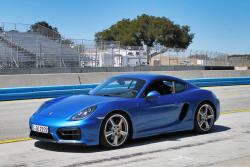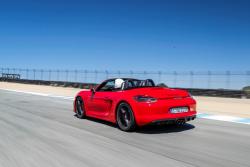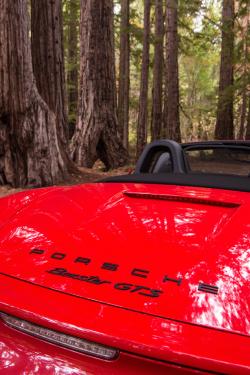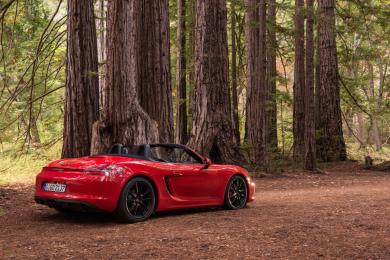  2015 Porsche Cayman GTS, Boxster GTS. Click image to enlarge |
Review by Justin Pritchard, photos by Justin Pritchard and courtesy of Porsche
A properly set up mid-engine car can feel as though it’s fist-punching the laws of physics square in the mouth. When the heaviest masses of the vehicle like the engine, transmission, fuel supply and occupants are concentrated centrally, the foundation is laid for a machine with higher-than-average responsiveness, agility, and high-speed stability.
Many of the world’s fastest, best-handling cars are built around this mid-engine premise, with less weight on the front wheels for enhanced steering feel and urgency, and more mass in the middle to make the car less prone to oversteer or understeer, and more prone to locking onto its line, even when pushed to the absolute limit. Weight is transferred with precision and grace between the axles in a mid-engine car under braking and acceleration giving drivers easy access to steering via the throttle and brakes.
It’s been over 20 years since the most recent mid-engine Porsche superstar, the Boxster, was revealed in concept form, before spawning a hard-top brother called the Cayman. Other examples exist in history. Porsche has built mid-engine cars for ages.
Porsche has offered GTS models for ages too – even some five decades ago with the mid-engine 904 GTS, and more recently, special variants of the 911, Panamera and Cayenne. These models intended to be the most athletic, high-value units available without going into each model’s range-topping Turbo variants. Now, for the first time in a long time, the GTS principle has been applied to the latest mid-engine Porsche model range.
It’s a simple principle. Add a little more power, a little more wheel and tire, and bundle it with the latest Porsche must-have performance tech as standard, and you’ve got the hottest versions of the Boxster and Cayman available. For GTS duty, these mechanical twins also get exclusive interior and exterior visual treatments and their own exclusive range of add-on options for customization.
   2015 Porsche Cayman GTS, Boxster GTS. Click image to enlarge |
They promise good value too, thanks to thousands of dollars of savings on the standard bundle of up-level go-fast goodies included with both. You’d spend plenty more adding the bigger tire and wheel kit, the newly-refined PASM suspension technology, Sports Exhaust with push-button bypass, and Sport Chrono package with launch control and dynamic transmission mounts to a standard Cayman or Boxster as individual options. Doing so still wouldn’t add the exclusive visuals either, or the boost of 15 horses apiece that bump Boxster GTS and Cayman GTS output to 330 and 340 horsepower respectively. So, these are some high-value performance models.
They build on a solid dynamic foundation and exhibit an underlying characteristic you’ll find even in the base-model machines: that is, a driving experience that feels carefully honed on a circuit, with braking performance expertly tuned to the power output, steering which feels beautifully dialed in against the weight of the car and the stiffness of the chassis, and a package that’s big on overall balance. No part of the performance spectrum overwhelms any other. And it all comes together at the driver’s fingers and toes with a polished feel you won’t find as abundant in a performance car built on a volume-model chassis with some add-on parts. Boxster and Cayman were designed as pure sports cars from the get-go, remember.
  2015 Porsche Boxster GTS, Cayman GTS. Click image to enlarge |
Notably, the steering is quick and eager and playful, the chassis is delightfully sensitive to weight transfer and easy to pitch and rotate with the pedals, and it all rewards smooth and gentle inputs, which contributes to a world-class handling experience that’s not exhausting or tiresome for its driver, even many laps in.
With the S, and especially the GTS variants of the Cayman and Boxster, the premise of this frisky and effortless confidence remains fully intact – though with more braking capability to match the additional power output, and more grip from the tires to match the sportier, self-optimizing PASM suspension. Result? The same balanced overall character, but with higher speeds, added stability, deeper braking, and a higher likelihood that the seatbelt is the only thing holding your spleen inside of your torso as g-forces build in fast corners.
Steering is quick enough to capitalize on the front-end’s lightness, but without being hyperactive or nervous. It loads up nicely in corners at high speed, directing the chassis with a sense of playful precision, and communicating what’s happening at the contact patches, as well as the weight of the car, to the driver clearly.
  2015 Porsche Boxster GTS, Cayman GTS. Click image to enlarge |
In the GTS machines, the added power is delivered alongside a huge increase in engine volume with the standard Sports Exhaust, and the little added width in the tires turns in a lot more overall grip, assisted by the Porsche Active Suspension Management (PASM) system which takes active control of suspension and body movements to keep things even more stable. This system now uses more sensors to make better, faster decisions about real-time damping and body motion control, so it’s more effective than ever.
There’s a downshift auto rev-matching function if you go with the manual transmission, and a new Torque Vectoring system that helps pitch the rear of the car into bends with inner-wheel braking and overdriving of the outside drive wheel. In GTS grade, then, Cayman and Boxster offer more grip and agility, do much more for their driver, and still deliver the trademark mid-engine driving feel, but in higher quantities. It all feels remarkably dialed-in, tuned, calibrated, and set-up.
  2015 Porsche Boxster GTS, Cayman GTS. Click image to enlarge |
But what makes these new GTS models so enjoyable and pleasing to push hard might be less about what you feel, and more about what you don’t. Any car, especially driven hard, is always in a state of struggle. Its weight tries to keep it from accelerating. Its momentum wants it to go straight, not to turn a corner. Mass tries to keep the car moving when drivers want it to stop. That’s all a given. Every car is subject to these sorts of struggles. It’s the rules.
|
Related Articles: Manufacturer’s Website: Photo Gallery: |
But in Cayman and Boxster, and perhaps especially in the GTS models, you feel less like you’re in a struggle and more like you’re being backed up and supported by a machine that’s working with, not against, Newton’s laws. Responses to braking, throttle and steering inputs are immediate, precise and executed with curious enthusiasm. There’s no hesitation or delay, there’s minimal sense of ever fighting the car or arguing with it to go where it’s pointed, and even the sound of the flat-six engine flooding into the cabin sounds gloriously potent, not strained.
In any case, all skill levels are covered here. In the GTS models, more novice drivers can expect to feel fully backed-up for spirited or closed-course driving, able to access plenty of the machine’s capability from the get go. Suspension, stability control, transmission and throttle operation can be toggled between various modes to match the course, intention or skill level at play – meaning experienced drivers will feel right at home, too. A good thing – as ultimately, shoppers planning to participate in motorsports activities will experience the highest return on their investment in the performance services of the new GTS machines.
For a Boxster GTS or Cayman GTS, fully loaded with the sort of add-on go-fast tech optional in non-GTS models, that investment starts in the mid-eighties.











